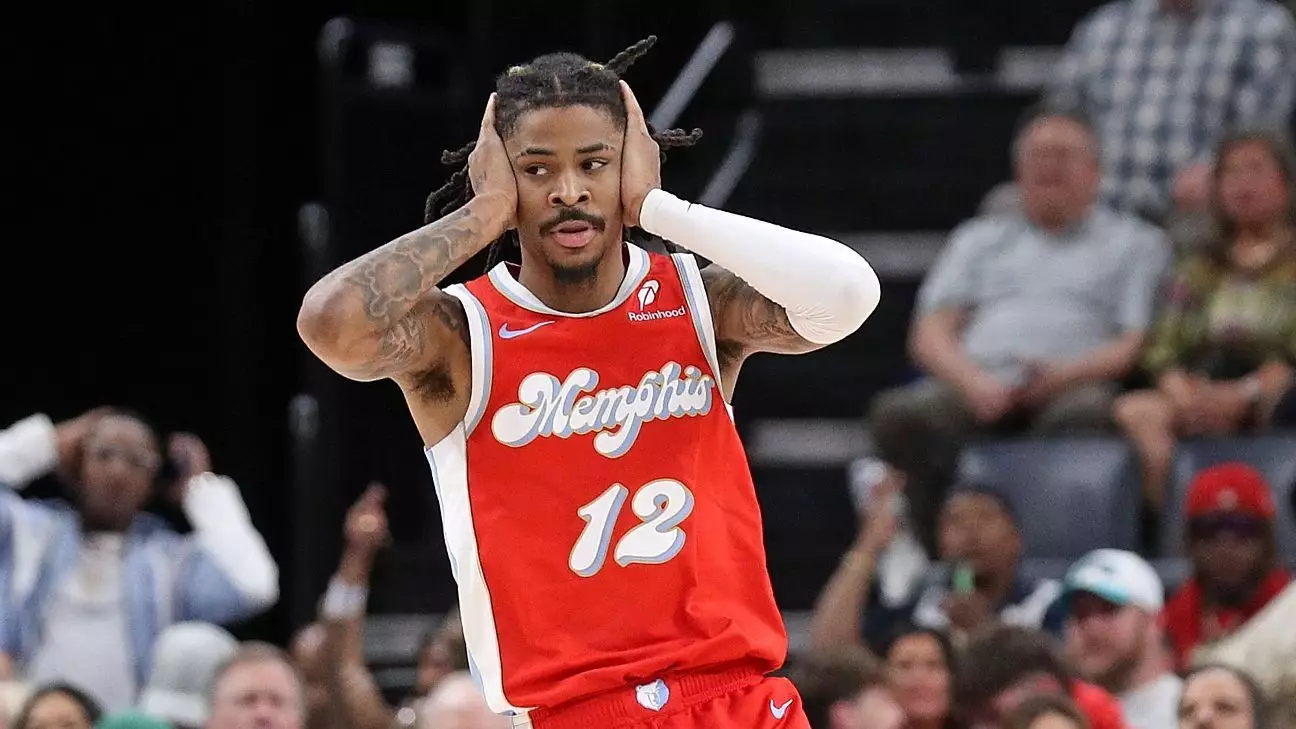Morant’s Evolution: From Imaginary Guns to Make-Believe Grenades
Hey there, fellow basketball enthusiasts! If you’ve been keeping an eye on the NBA recently, you might have noticed Ja Morant making headlines again. This time, it’s not just his incredible athleticism that’s caught our attention, but rather his unique way of celebrating three-point shots. Morant, the charismatic player from the Memphis Grizzlies, has shifted from mimicking gun gestures—a move that previously cost him a $75,000 fine—to now pretending to pull the pin on an imaginary grenade. This new celebratory style debuted during an intense game against the Minnesota Timberwolves and has sparked quite a bit of conversation.
It’s fascinating to see how athletes like Morant navigate their careers, especially when under such public scrutiny. These gestures are more than just playful antics; they reflect deeper aspects of personality and pressure. As someone who loves following both sports and personal narratives, I find Morant’s journey incredibly intriguing. His choices on the court not only entertain us but also bring up important discussions about responsibility and the impact of public figures.
In the world of professional sports, where every move is watched and analyzed, players like Morant stand at the intersection of self-expression and societal expectations. It’s a delicate dance that requires both creativity and awareness. Let’s dive into what this evolution means for him and those who watch his every move with bated breath.
Key Takeaways
- Morant’s shift from gun gestures to grenade mimicry highlights his attempt to balance creativity with controversy.
- The public reaction underscores the importance of responsible behavior by influential athletes.
- This evolution is part of a larger dialogue about player conduct and societal expectations.
The Shift in Celebratory Gestures
Ja Morant’s latest celebration style—mimicking the act of throwing a grenade—clearly marks a creative pivot from his past gestures. This change seems to acknowledge the scrutiny he faces due to his previous antics with imaginary firearms. The NBA has been clear in its stance on gestures that could be deemed inappropriate or offensive, especially given the sensitive nature of gun-related topics. By adopting this new method, Morant walks a tightrope between clever innovation and potential misunderstanding.
While some fans find humor in this imaginative display, others see it as another risky move. The TNT studio crew and other commentators have expressed concerns that such gestures might trivialize serious issues like gun violence. For Morant, who has already faced league penalties including a significant suspension, this new celebratory act might inadvertently bring more criticism his way. However, it’s also a testament to his willingness to explore new avenues for expression on the court.
Public Perception and Responsibility
In sports, as in life, perception plays a crucial role in shaping narratives. For Morant, each gesture carries weight far beyond its initial intention. Despite his playful nature, the backlash surrounding his grenade-tossing celebration serves as a reminder of the broader responsibilities athletes hold. Some argue that these gestures dodge important discussions about gun violence—a pressing issue in many communities—and contribute little to resolving such social challenges.
Morant’s actions also highlight ongoing concerns about player conduct within professional leagues. With previous incidents involving firearms leading to disciplinary actions like suspensions, Morant’s story serves as a lens through which we examine accountability among athletes. In today’s culture where young fans look up to sports heroes for guidance, how these figures conduct themselves can have lasting impacts on their audience.
A Path of Redemption or Recklessness?
The debate over Morant’s celebrations extends into conversations about athlete responsibility versus personal freedom. Teammate Vince Williams Jr., supportive of Morant’s financial well-being, underscores this tension by backing his celebratory choices. Yet, there’s an inherent risk in normalizing behaviors that might appear reckless or insensitive given society’s current challenges with violence and security.
As Morant continues to evolve both as a player and public figure, he must weigh his desire for self-expression against societal expectations. His influence on fans—particularly impressionable youth—cannot be understated. Therefore, navigating this complex landscape requires thoughtful consideration and dialogue between athletes like Morant and their audiences about what these acts mean in modern times.
Final Thoughts
In closing, Ja Morant’s evolution from imaginary guns to make-believe grenades is emblematic of a larger journey many athletes face today: balancing personal identity with public accountability. While these celebrations may seem minor in isolation, they spark significant debate touching on societal norms and expectations for those in the limelight. As fans and observers continue watching Morant’s career unfold, it remains crucial for everyone involved—players and audiences alike—to engage in reflective conversations about responsibility and influence within sport.
This story reminds us all that sports are not just games; they’re cultural touchstones that reflect broader societal dynamics. By understanding this context, we can appreciate both the entertainment value and deeper implications behind each play.
Ja Morant
NBA
sports responsibility
athlete behavior


Leave a Reply